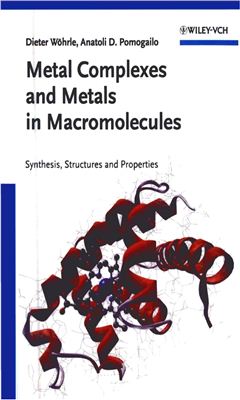Wiley-VCH. 2003. 685 p.
Metals and metal complexes can form compounds with organic macromolecules that show amazing properties. As is so often the case, nature leads by example. Synthetically produced model compounds, such as phthalocyanines, porphyrines or metalloproteins, as well as metallorganic polymers have aroused much interest in materials science. Their special magnetic, electrochemical and photochemical properties open up new perspectives in microelectronics and sensors.
This compact manual is aimed at all organic, inorganic, polymer and physical chemists as well as materials scientists looking for competent and detailed information on the current state of this interdisciplinary area of research. It covers all questions relating to the targeted design of metallic macromolecules, from proven synthesis methods right up to the latest strategies. It also treats major progress in the determination of their structures, the physical-chemical properties of promising compounds and their potential in microelectronics and sensors. Furthermore, the most important methods of synthesis and investigation are presented in detail in an experimental section, while a comprehensive collection of pertinent original literature rounds off this unique reference on all matters relating to macromolecular metal complexes.
Contents
Overview and biological systems
Definitions, Classifications, History, Properties
Macromolecular Metal Complexes in Biological Systems
Synthesis and structures
Kinetics and Thermodynamics of Formation of Macromolecular Metal Complexes and Their Structural Organization
Polymerization of Metal-Containing Monomers (MCMs) as a Method for Incorporating Metals in Macromolecules
Binding of Metal Ions and Metal Complexes to Macromolecular Carriers
Metal Complexes as Part of Linear or Cross-linked Macromolecules via the Ligand
Metals or Metal Complexes as Part of Linear or Crosslinked Macromolecules via the Metal
Metal Complexes or Clusters Physically Embedded in Macromolecules
Properties
Binding of Small Molecules
Physical and Optical Sensors
Catalysis by Soluble Macromolecular Metal Complexes
The State of the Art and Perspectives in Catalysis by Heterogenized Polymer-Bound Metal Complexes
Photocatalytic Properties
Electron- and Photon-Induced Processes
Outlook
Metals and metal complexes can form compounds with organic macromolecules that show amazing properties. As is so often the case, nature leads by example. Synthetically produced model compounds, such as phthalocyanines, porphyrines or metalloproteins, as well as metallorganic polymers have aroused much interest in materials science. Their special magnetic, electrochemical and photochemical properties open up new perspectives in microelectronics and sensors.
This compact manual is aimed at all organic, inorganic, polymer and physical chemists as well as materials scientists looking for competent and detailed information on the current state of this interdisciplinary area of research. It covers all questions relating to the targeted design of metallic macromolecules, from proven synthesis methods right up to the latest strategies. It also treats major progress in the determination of their structures, the physical-chemical properties of promising compounds and their potential in microelectronics and sensors. Furthermore, the most important methods of synthesis and investigation are presented in detail in an experimental section, while a comprehensive collection of pertinent original literature rounds off this unique reference on all matters relating to macromolecular metal complexes.
Contents
Overview and biological systems
Definitions, Classifications, History, Properties
Macromolecular Metal Complexes in Biological Systems
Synthesis and structures
Kinetics and Thermodynamics of Formation of Macromolecular Metal Complexes and Their Structural Organization
Polymerization of Metal-Containing Monomers (MCMs) as a Method for Incorporating Metals in Macromolecules
Binding of Metal Ions and Metal Complexes to Macromolecular Carriers
Metal Complexes as Part of Linear or Cross-linked Macromolecules via the Ligand
Metals or Metal Complexes as Part of Linear or Crosslinked Macromolecules via the Metal
Metal Complexes or Clusters Physically Embedded in Macromolecules
Properties
Binding of Small Molecules
Physical and Optical Sensors
Catalysis by Soluble Macromolecular Metal Complexes
The State of the Art and Perspectives in Catalysis by Heterogenized Polymer-Bound Metal Complexes
Photocatalytic Properties
Electron- and Photon-Induced Processes
Outlook

